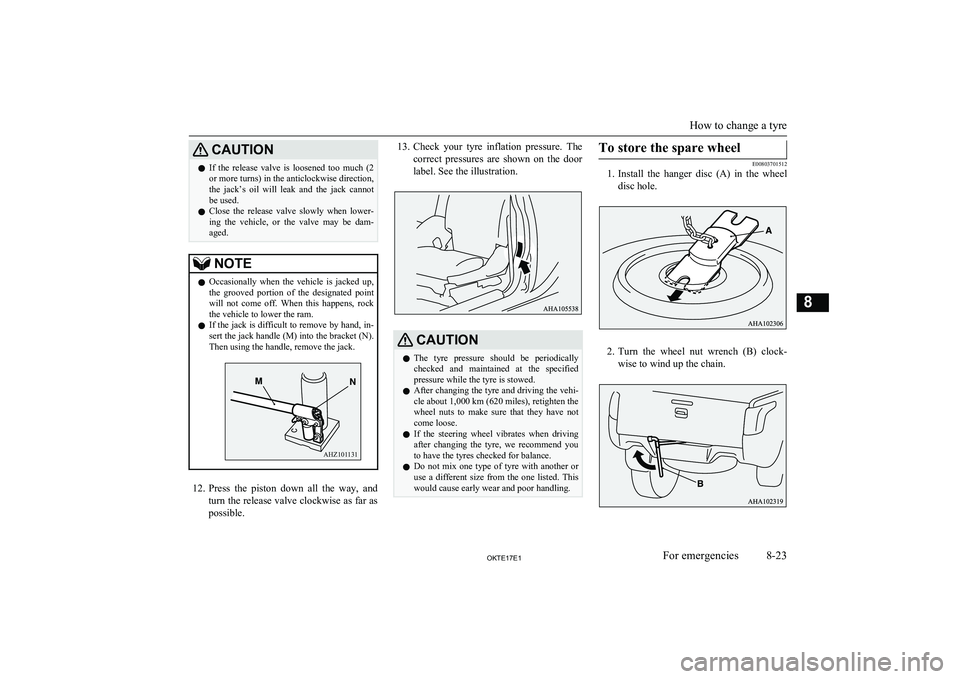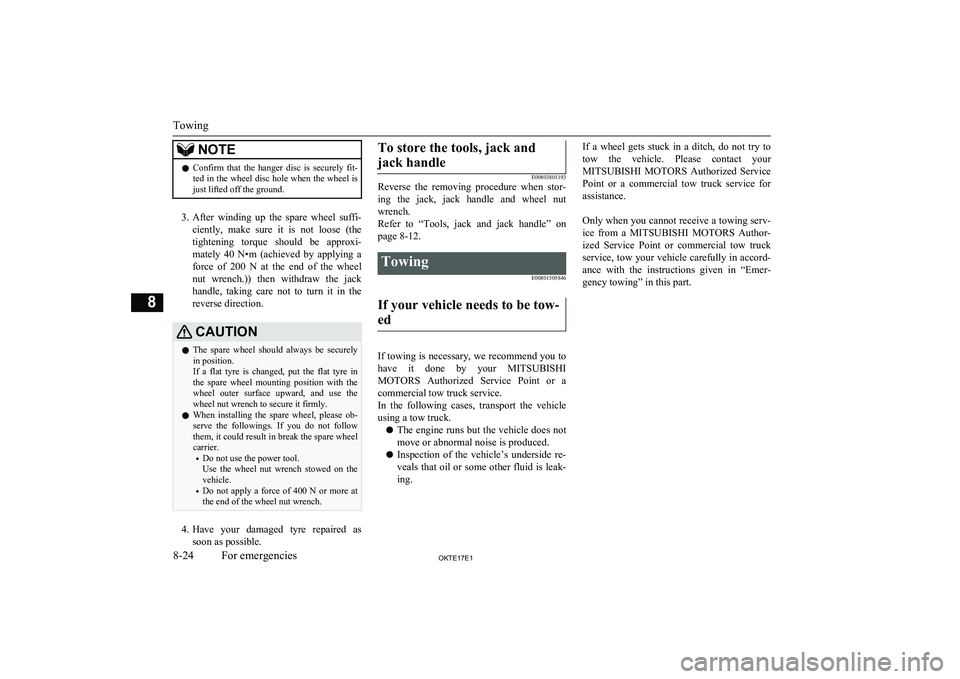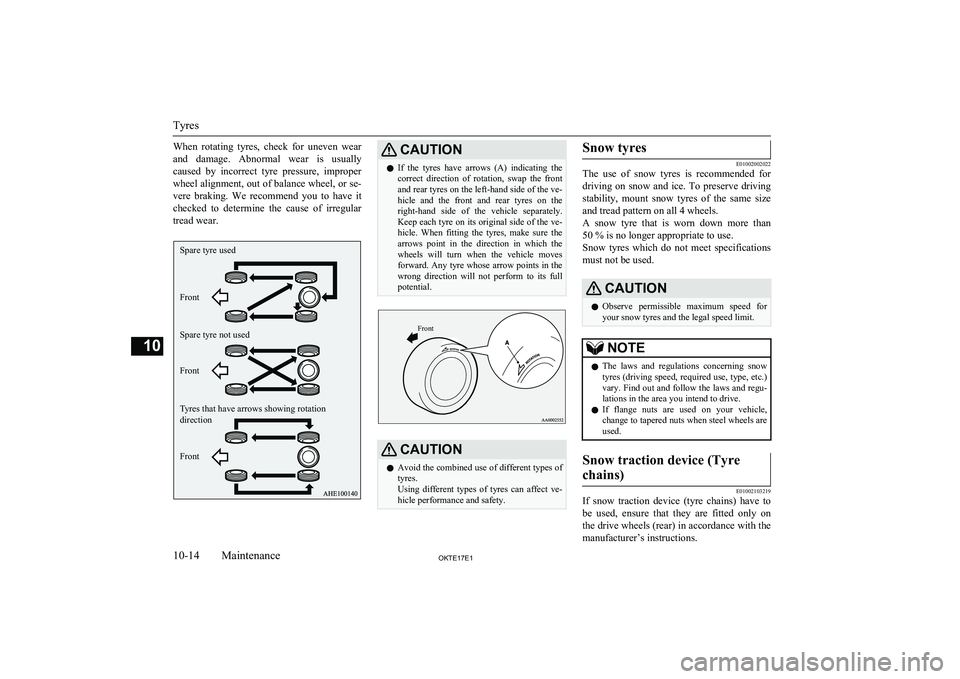wheel nut MITSUBISHI L200 2017 (in English) User Guide
[x] Cancel search | Manufacturer: MITSUBISHI, Model Year: 2017, Model line: L200, Model: MITSUBISHI L200 2017Pages: 426, PDF Size: 14.12 MB
Page 335 of 426

CAUTIONlIf the release valve is loosened too much (2
or more turns) in the anticlockwise direction, the jack’s oil will leak and the jack cannot
be used.
l Close the release valve slowly when lower-
ing the vehicle, or the valve may be dam-
aged.NOTEl Occasionally when the vehicle is jacked up,
the grooved portion of the designated pointwill not come off. When this happens, rock
the vehicle to lower the ram.
l If the jack is difficult to remove by hand, in-
sert the jack handle (M) into the bracket (N).
Then using the handle, remove the jack.
12. Press the piston down all the way, and
turn the release valve clockwise as far as possible.
13. Check your tyre inflation pressure. The
correct pressures are shown on the door
label. See the illustration.CAUTIONl The tyre pressure should be periodically
checked and maintained at the specified pressure while the tyre is stowed.
l After changing the tyre and driving the vehi-
cle about 1,000 km (620 miles), retighten the
wheel nuts to make sure that they have not come loose.
l If the steering wheel vibrates when driving
after changing the tyre, we recommend you to have the tyres checked for balance.
l Do not mix one type of tyre with another or
use a different size from the one listed. This
would cause early wear and poor handling.To store the spare wheel
E00803701512
1. Install the hanger disc (A) in the wheel
disc hole.
2. Turn the wheel nut wrench (B) clock-
wise to wind up the chain.
How to change a tyre
8-23OKTE17E1For emergencies8 AHZ101131
Page 336 of 426

NOTElConfirm that the hanger disc is securely fit-
ted in the wheel disc hole when the wheel isjust lifted off the ground.
3. After winding up the spare wheel suffi-
ciently, make sure it is not loose (the tightening torque should be approxi-
mately 40 N•m (achieved by applying a force of 200 N at the end of the wheel nut wrench.)) then withdraw the jack
handle, taking care not to turn it in the
reverse direction.
CAUTIONl The spare wheel should always be securely
in position.
If a flat tyre is changed, put the flat tyre in
the spare wheel mounting position with the wheel outer surface upward, and use the wheel nut wrench to secure it firmly.
l When installing the spare wheel, please ob-
serve the followings. If you do not follow
them, it could result in break the spare wheel
carrier.
• Do not use the power tool.
Use the wheel nut wrench stowed on the vehicle.
• Do not apply a force of 400 N or more at
the end of the wheel nut wrench.
4. Have your damaged tyre repaired as
soon as possible.
To store the tools, jack and
jack handle
E00803801193
Reverse the removing procedure when stor-
ing the jack, jack handle and wheel nut
wrench.
Refer to “Tools, jack and jack handle” on page 8-12.
Towing
E00801505846
If your vehicle needs to be tow-
ed
If towing is necessary, we recommend you to have it done by your MITSUBISHI
MOTORS Authorized Service Point or a
commercial tow truck service.
In the following cases, transport the vehicle
using a tow truck.
l The engine runs but the vehicle does not
move or abnormal noise is produced.
l Inspection of the vehicle’s underside re-
veals that oil or some other fluid is leak- ing.
If a wheel gets stuck in a ditch, do not try to
tow the vehicle. Please contact your
MITSUBISHI MOTORS Authorized Service
Point or a commercial tow truck service for assistance.
Only when you cannot receive a towing serv- ice from a MITSUBISHI MOTORS Author-
ized Service Point or commercial tow truck
service, tow your vehicle carefully in accord- ance with the instructions given in “Emer-gency towing” in this part.
Towing
8-24OKTE17E1For emergencies8
Page 362 of 426

When rotating tyres, check for uneven wear
and damage. Abnormal wear is usually caused by incorrect tyre pressure, improper wheel alignment, out of balance wheel, or se-
vere braking. We recommend you to have it checked to determine the cause of irregular
tread wear.CAUTIONl If the tyres have arrows (A) indicating the
correct direction of rotation, swap the front
and rear tyres on the left-hand side of the ve- hicle and the front and rear tyres on the right-hand side of the vehicle separately.
Keep each tyre on its original side of the ve- hicle. When fitting the tyres, make sure the
arrows point in the direction in which the wheels will turn when the vehicle moves
forward. Any tyre whose arrow points in the wrong direction will not perform to its fullpotential.Front
CAUTIONl Avoid the combined use of different types of
tyres.
Using different types of tyres can affect ve-
hicle performance and safety.Snow tyres
E01002002022
The use of snow tyres is recommended for
driving on snow and ice. To preserve driving stability, mount snow tyres of the same size and tread pattern on all 4 wheels.
A snow tyre that is worn down more than
50 % is no longer appropriate to use.
Snow tyres which do not meet specifications must not be used.
CAUTIONl Observe permissible maximum speed for
your snow tyres and the legal speed limit.NOTEl The laws and regulations concerning snow
tyres (driving speed, required use, type, etc.)
vary. Find out and follow the laws and regu- lations in the area you intend to drive.
l If flange nuts are used on your vehicle,
change to tapered nuts when steel wheels are used.Snow traction device (Tyre
chains)
E01002103219
If snow traction device (tyre chains) have to
be used, ensure that they are fitted only on
the drive wheels (rear) in accordance with the manufacturer’s instructions.
Tyres
10-14OKTE17E1Maintenance10Spare tyre used
Front
Spare tyre not used
Front
Tyres that have arrows showing rotation
direction
Front